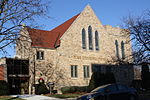SS Selah Chamberlain
1873 shipsGreat Lakes freightersMaritime incidents in 1881Maritime incidents in November 1883Maritime incidents in October 1884 ... and 8 more
Maritime incidents in October 1886Merchant ships of the United StatesShips built in ClevelandShipwrecks of Lake MichiganShipwrecks of the Wisconsin coastShipwrecks on the National Register of Historic Places in WisconsinSteamships of the United StatesWreck diving sites in the United States

SS Selah Chamberlain was a wooden-hulled Great Lakes freighter that sank in Lake Michigan in 1886, 6 miles (10 km) off the coast of Sheboygan, Sheboygan County, Wisconsin, United States after being rammed by the steamer John Pridgeon Jr. with the loss of five lives. On January 7, 2019, the wreck of Selah Chamberlain was listed on the National Register of Historic Places, and was given the reference number 100003288. She was the first shipwreck listed on the National Register of Historic Places in 2019.
Excerpt from the Wikipedia article SS Selah Chamberlain (License: CC BY-SA 3.0, Authors, Images).SS Selah Chamberlain
Geographical coordinates (GPS) Address Nearby Places Show on map
Geographical coordinates (GPS)
| Latitude | Longitude |
|---|---|
| N 43.769933 ° | E -87.656683 ° |
Address
Sheboygan County
Wisconsin, United States
Open on Google Maps








